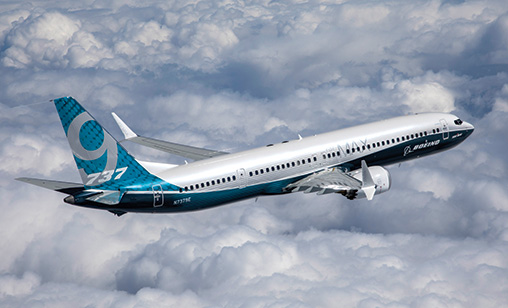News Backgrounder
Boeing targets Asia’s LCCs for B737 MAX business
Boeing’s latest single aisle aircraft, the B737 MAX, is the fastest selling aircraft in the company’s history. The U.S. planemaker is confident it will increase its market share in the Asia-Pacific, particularly at the region’s budget carriers.
May 1st 2017
When Boeing’s newest single-aisle aircraft, the B737 MAX 9, completed its first flight of two hours and 42 minutes over Puget Sound near Seattle on April 14, the plane maker’s executives were exuberant. Read More »
As rival Airbus continues to struggle with delays to its A320 neo program, mainly because of missed engine delivery deadlines from Pratt & Whitney, the April 14 flight confirmed the new series outperforms its rival at almost every level of competing assessments. The overall program is also ahead of schedule.
 |
After the first MAX 9 flight, which tested flight controls, systems and handling qualities, landed, Boeing vice president, Keith Leverkuhn, said: “The 737 MAX team continues to fire on all cylinders”. The MAX 9 has a maximum capacity of 220 passengers and a range of 3,515 nautical miles (6,509 kilometers).
But Airbus is not dragging its feet. The third member of its best-selling A320neo Family – the A319neo – performed its maiden flight on March 31, when it took off from Hamburg-Finkenwerder Airport and touched down five hours later at Airbus in Toulouse.
The shortest fuselage member of the A320neo product line is equipped with CFM International LEAP-1A engines – one of the two power plants available for the aircraft type. Airbus said that when the airliner is in service, it will provide the same remarkable fuel efficiency as the longer-fuselage A320neo and A321neo versions and also allow airlines to choose between three aircraft sizes of 100 to 240 seats.
“The choice allows carriers to match capacity with demand, covering the entire single-aisle jetliner segment from low and high density domestic operations to longer-range routes,” the manufacturer said.
But with more than 3,700 firm orders from 86 customers, including 870 orders from the Asia-Pacific, Boeing is certain its B737 Max 9 is a winner. Chief engineer and deputy program manager for the MAX, Michael Teal, said: “The MAX is designed for the fuel burn advantage. When you look at the MAX it flies higher and further. It flies faster. Its lighter weight burns less fuel and has less maintenance than the competitor.”
The launch flights of the -8 and -9 will be followed next year by the flying debut of the smaller -7. Another version of the type, the MAX 200, is being built. Basically, it is the same as the -8 with the additional feature of a mid-entry door that allows LCCs to install 11 more seats on the plane.
Another member of the MAX family, the larger -10 or 10X, looks closer to manufacture as Boeing believes it will attract big sales at budget carriers in Asia. At present, said Teal, the -10 “is offerable”. “We will launch the aircraft when customers are ready to buy it. If customers like the -10 it will likely be deliverable in 2020,” he said.
“When we talk about range capability, the MAX 8 has more range than the A320 and the MAX 9 has more range than the A321. The MAX 10 will have a range equivalent to the Boeing -900ER of today so the range capability of the MAX family is further than the competitor’s airplane.
“We also do it for a lot less fuel. So yes, I am optimistic we will make significant inroads into that market space in Asia. We are adding two more seat rows, or up to 12 passengers, on the MAX 10.
“Airlines looking for a range equivalent to the 900ER or better as well as the addition of two seat rows will have the choice of an aircraft with the lowest seat mile costs of any of the competitors’ aircraft. It also will bring in revenue from 12 more seats.”
Chinese airlines are “very interested” in the -9 and particularly the -10 because of its operating economics, Teal said.
Powered by the new CFM LEAP 1B engine, Boeing said the MAX series cuts fuel burn by 20% compared with its predecessor, the B737 NG. It also can fly between 400 to 500 nautical miles further than its rivals.
Asia-Pacific orders for the MAX series are: BOC Aviation (50), Korean Air (30), Lion Air (201), Virgin Australia (40), Silk Air (31), Nok Air (8), Okay Airways (6), Garuda Indonesia (50), Jet Airways (75), Air Niugini (4), VietJet Air (100), Malaysia Airlines (25), Fiji Airways (5), SpiceJet (205), Silk Way Airlines, Azerbaijan (40).